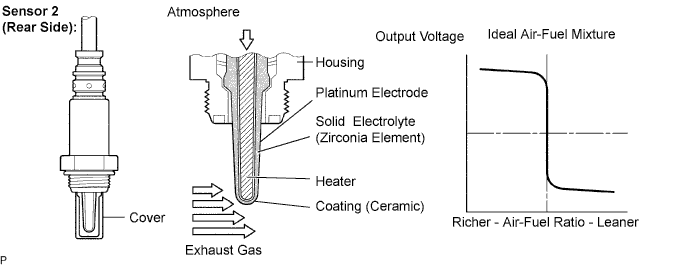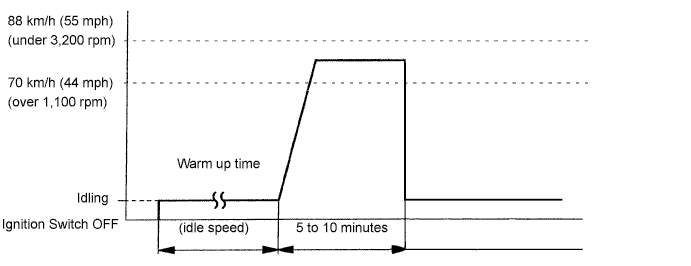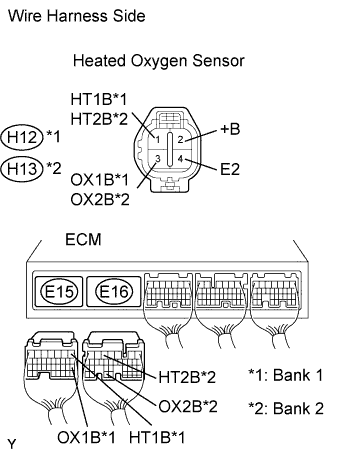Dtc P0136 Oxygen Sensor Circuit Malfunction (Bank 1 Sensor 2)
DESCRIPTION
WIRING DIAGRAM
CONFIRMATION DRIVING PATTERN
INSPECTION PROCEDURE
CHECK OTHER DTC OUTPUT (BESIDES DTC P0136, P0137, P0138, P0156, P0157 AND/OR P0158)
READ VALUE USING INTELLIGENT TESTER (OUTPUT VOLTAGE OF HEATED OXYGEN SENSOR)
INSPECT HEATED OXYGEN SENSOR (HEATER RESISTANCE)
INSPECT INTEGRATION NO.1 RELAY (MAIN RELAY)
CHECK WIRE HARNESS (HEATED OXYGEN SENSOR - ECM)
PERFORM CONFIRMATION DRIVING PATTERN
READ OUTPUT DTC (DTC P0136 AND/OR P0156 ARE OUTPUT AGAIN)
DTC P0136 Oxygen Sensor Circuit Malfunction (Bank 1 Sensor 2) |
DTC P0137 Oxygen Sensor Circuit Low Voltage (Bank 1 Sensor 2) |
DTC P0138 Oxygen Sensor Circuit High Voltage (Bank 1 Sensor 2) |
DTC P0156 Oxygen Sensor Circuit Malfunction (Bank 2 Sensor 2) |
DTC P0157 Oxygen Sensor Circuit Low Voltage (Bank 2 Sensor 2) |
DTC P0158 Oxygen Sensor Circuit High Voltage (Bank 2 Sensor 2) |
DESCRIPTION
The heated oxygen sensor is a planar type. Compared to the conventional type, the sensor and heater portions are narrower. The heat of the heater is conducted to the zirconia element through the alumina, accelerating sensor activation.To obtain a high purification rate of carbon monoxide (CO), hydrocarbon (HC) and nitrogen oxide (NOx) in the exhaust gas, a Three-Way Catalytic Converter (TWC) is used. For the most efficient use of the three-way catalytic converter, the air-fuel ratio must be precisely controlled so that it is always close to the stoichiometric air-fuel ratio.The heated oxygen sensor has the characteristic whereby its output voltage changes suddenly in the vicinity of the stoichiometric air-fuel ratio. This is used to detect the oxygen concentration in the exhaust gas and provide the ECM with feedback control the air-fuel ratio.When the air-fuel ratio becomes lean, the oxygen concentration in the exhaust gas increases. And the heated oxygen sensor informs the ECM of the lean condition (small electromotive force: Less than 0.45 V).When the air-fuel ratio is richer than the stoichiometric air-fuel ratio, the oxygen concentration in the exhaust gas is reduced. And the heated oxygen sensor informs the ECM of the rich condition (large electromotive force: More than 0.45 V). The ECM judges by the electromotive force from the heated oxygen sensor whether the air-fuel ratio is rich or lean and controls the injection time accordingly. If the malfunction of the heated oxygen sensor causes an output of abnormal electromotive force, the ECM becomes unable to perform the accurate air-fuel ratio control.The heated oxygen sensors include a heater which heats the zirconia element. The heater is controlled by the ECM. When the intake air volume is low (the temperature of the exhaust gas is low), current flows to the heater in order to heat the sensor for accurate oxygen concentration detection.
DTC No.
| DTC Detection Condition
| Trouble Area
|
P0136
P0156
| During active control, heated oxygen sensor output voltage is 0.2 to 0.6 V
| - Open or short in heated oxygen sensor (bank 1, 2 sensor 2) circuit
- Heated oxygen sensor (bank 1, 2 sensor 2)
- Heated oxygen sensor heater (bank 1, 2 sensor 2)
- Integration relay
|
P0136
P0156
| (a) and (b) are met for more than 90 seconds
(a) Estimated rear oxygen sensor temperature is less than 800°C (1,472°F)
(b) Rear oxygen sensor impedance is less than 5 Ω
|
P0137
P0157
| During active control, heated oxygen sensor output voltage is less than 0.2 V
|
P0137
P0157
| (a) and (b) are met for more than 90 seconds
(a) Estimated rear oxygen sensor temperature is less than 450°C (842°F)
(b) Rear oxygen sensor impedance is more than 15 kΩ
|
P0138
P0158
| During active control, heated oxygen sensor output voltage is more than 0.6 V
|
P0138
P0158
| Rear oxygen sensor output voltage is 1.2 V or higher for more than 30 seconds
|
- HINT:
- Bank 1 refers to the bank that includes the No. 1 cylinder.
- Bank 2 refers to the bank that does not include the No. 1 cylinder.
- Sensor 2 refers to the sensor farther away from the engine assembly.
WIRING DIAGRAM
CONFIRMATION DRIVING PATTERN
- HINT:
- Performing this confirmation pattern will activate the DTC detection (P0136) of the ECM. This is very useful for verifying the completion of a repair.
- (a) Clear the DTC (Toyota Fortuner RM0000010E700JX.html).
- (b) Using the tester, change the ECM from normal mode to check mode (Toyota Fortuner RM000000PDL017X.html).
- (c) Start the engine and warm it up with all the accessory switches OFF.
- (d) Deactivate the inspection mode and drive the vehicle at 70 to 120 km/h (44 to 70 mph) for 5 to 10 minutes.
- (e) Read DTCs.
- NOTICE:
- If the conditions in this test are not strictly followed, no malfunction will be detected.
INSPECTION PROCEDURE
- (a) Connect the intelligent tester to the DLC3.
- HINT:
- It is possible the malfunctioning area can be found using the Active Test "Control the injection volume for A/F sensor" operation. The Active Test can determine if the heated oxygen sensor or other potential trouble areas are malfunctioning or not.
- The injection volume can be switched to -12.5% (decrease) or +25% (increase) by the Active Test.
- The Active Test procedure enables a technician to check and graph the output voltage of the heated oxygen sensors.
- (b) Turn the ignition switch ON.
- (c) Warm up the engine with the engine speed at 2,500 rpm for approximately 90 seconds.
- (d) Enter the following menus: Powertrain / Engine and ECT / Active Test / Control the injection volume for A/F sensor.
- (e) Perform the Active Test while the engine is idling.
- Standard voltage:
Tester Display
(Sensor)
| Injection Volume
| Status
| Voltage
|
AFS B1S1 or AFS B2S1
(A/F)
| +25%
| Rich
| Less than 3.0 V
|
AFS B1S1 or AFS B2S1
(A/F)
| -12.5%
| Lean
| More than 3.35 V
|
O2S B1S1 or O2S B2S2
(heated oxygen sensor)
| +25%
| Rich
| More than 0.55 V
|
O2S B1S1 or O2S B2S2
(heated oxygen sensor)
| -12.5%
| Lean
| Less than 0.4 V
|
- NOTICE:
- The A/F sensor output has a few seconds of delay and the heated oxygen sensor output has approximately 20 seconds of delay.
Case
| A/F Sensor (Sensor 1) Output Voltage
| HO2 Sensor (Sensor 2) Output Voltage
| Main Suspected Trouble Area
|
1
| 

| 

| -
|
2
| 

| 

| - A/F sensor
- A/F sensor heater
- A/F sensor circuit
|
3
| 

| 

| - HO2 sensor
- HO2 sensor heater
- HO2 sensor circuit
|
4
| 

| 

| - Fuel injector
- Fuel pressure
- Gas leak from exhaust system (air-fuel ratio extremely rich or lean)
|
The following "Control the injection volume for A/F sensor" procedure enables the technician to check and graph the output voltage of both A/F sensor and heated oxygen sensor.- HINT:
- Read freeze frame data using the intelligent tester. Freeze frame data records the engine conditions when a malfunction is detected. When troubleshooting, freeze frame data can help determine if the vehicle was running or stopped, if the engine was warmed up or not, if the air-fuel ratio was lean or rich, and other data from the time the malfunction occurred.
- A low A/F sensor voltage could be caused by a rich air-fuel mixture. Check the conditions that would cause the engine to run with a rich air-fuel mixture.
- A high A/F sensor voltage could be caused by a lean air-fuel mixture. Check the conditions that would cause the engine to run with a lean air-fuel mixture.
- Sensor 2 refers to the sensor mounted behind the Three-Way Catalytic Converter (TWC) and located far from the engine assembly.
| 1.CHECK OTHER DTC OUTPUT (BESIDES DTC P0136, P0137, P0138, P0156, P0157 AND/OR P0158) |
Connect the intelligent tester to the DLC3.
Turn the ignition switch ON and turn the tester ON.
Enter the following menus: Powertrain / Engine and ECT / DTC.
Read the DTCs.
- Result:
Display (DTC output)
| Proceed to
|
Only P0136, P0137, P0138, P0156, P0157 and/or P0158 are output
| A
|
P0136, P0137, P0138, P0156, P0157 and/or P0158 and other DTCs are output
| B
|
- HINT:
- If any other codes besides P0136, P0137, P0138, P0156, P0157 and/or P0158 are output, perform troubleshooting for those DTCs first.
| 2.READ VALUE USING INTELLIGENT TESTER (OUTPUT VOLTAGE OF HEATED OXYGEN SENSOR) |
After warming up the engine, race the engine at 2,500 rpm for 3 minutes.
Read the output voltage of the heated oxygen sensor when the engine is suddenly raced.
- HINT:
- Quickly perform racing to 4,000 rpm 3 times by using the accelerator pedal.
- Standard voltage:
- Alternates between 0.4 V or less and 0.5 V or more.
| 3.INSPECT HEATED OXYGEN SENSOR (HEATER RESISTANCE) |
Disconnect the H12 and H13 heated oxygen sensor connectors.
Measure the resistance of the sensor.
- Standard resistance:
Bank 1 Sensor 2Tester Connection
| Condition
| Specified Condition
|
1 (HT1B) - 2 (+B)
| 20°C (68°F)
| 11 to 16 Ω
|
1 (HT1B) - 4 (E2)
| -
| 10 kΩ or higher
|
Bank 2 Sensor 2Tester Connection
| Condition
| Specified Condition
|
1 (HT2B) - 2 (+B)
| 20°C (68°F)
| 11 to 16 Ω
|
1 (HT2B) - 4 (E2)
| -
| 10 kΩ or higher
|
| | REPLACE HEATED OXYGEN SENSOR |
|
|
| 4.INSPECT INTEGRATION NO.1 RELAY (MAIN RELAY) |
Disconnect the integration relay from the engine room junction block.
Measure the voltage of the MAIN relay.
- Standard resistance:
Tester Connection
| Condition
| Specified Condition
|
1J-5 - Body ground
| Ignition switch ON
| 10 to 14 V
|
| | REPLACE INTEGRATION NO.1 RELAY |
|
|
| 5.CHECK WIRE HARNESS (HEATED OXYGEN SENSOR - ECM) |
Disconnect the H12 and H13 connectors.
Disconnect the E15 and E16 ECM connectors.
Measure the resistance of the wire harness side connectors.
- Standard resistance:
Bank 1 Sensor 2Tester Connection
| Specified Condition
|
H12-1 (HT1B) - E15-1 (HT1B)
| Below 1 Ω
|
H12-3 (OX1B) - E15-18 (OX1B)
| Below 1 Ω
|
H12-1 (HT1B) or E15-1 (HT1B) - Body ground
| 10 kΩ or higher
|
H12-3 (OX1B) or E15-18 (OX1B) - Body ground
| 10 kΩ or higher
|
Bank 2 Sensor 2Tester Connection
| Specified Condition
|
BH13-1 (HT2B) - E16-5 (HT2B)
| Below 1 Ω
|
H13-3 (OX2B) - E16-33 (OX2B)
| Below 1 Ω
|
H13-1 (HT2B) or E16-5 (HT2B) - Body ground
| 10 kΩ or higher
|
H13-3 (OX2B) or E16-33 (OX2B) - Body ground
| 10 kΩ or higher
|
| | REPAIR OR REPLACE HARNESS AND CONNECTOR |
|
|
| OK |
|
|
|
| REPLACE HEATED OXYGEN SENSOR |
|
| 6.PERFORM CONFIRMATION DRIVING PATTERN |
- HINT:
- Clear all DTCs prior to performing the confirmation driving pattern.
| 7.READ OUTPUT DTC (DTC P0136 AND/OR P0156 ARE OUTPUT AGAIN) |
Connect the intelligent tester to the DLC3.
Turn the ignition switch ON and turn the tester ON.
Enter the following menus: Powertrain / Engine and ECT / DTC.
Read the DTCs.
- Result:
Display (DTC output)
| Proceed to
|
P0136 and/or P0156 are not output again
| A
|
P0136 and/or P0156 are output again
| B
|
| | REPLACE HEATED OXYGEN SENSOR |
|
|
| A |
|
|
|
| CHECK FOR INTERMITTENT PROBLEMS |
|





















